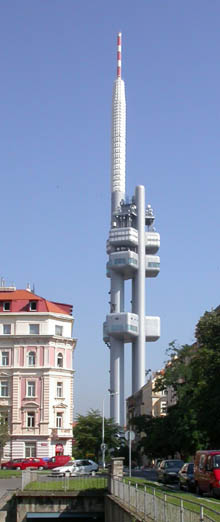
People have gotten used to the initially rejected tower over 20 years
 |
Over time, especially after the statues of David Černý appeared on the tower five years ago, people began to accept the structure. Now it can attract families, tourists, and longtime residents alike. Some people have bungee jumped from the tower, parties are organized there, and this year it hosted the Entermultimediale festival of new media in art.
Architecture students today admirably say about the tower's author that he must have been brave to push through such a building despite the regime. However, the reality was different - the transmitter was a state contract. It began construction 20 years ago and was commissioned in 1992.
"Back then, we were convinced that the tower was being built as a jamming device to drown out broadcasts from abroad with a strong signal. We saw it as a structure that symbolizes the arrogance of power," said modern architecture historian Zdeněk Lukeš to ČTK. Architecturally, he considers the tower not very successful - it is very massive and insensitively disrupts most views from the center of Prague.
"Given the more than two-hundred-meter height of the tower, it is a pity that the viewing platform is not higher, but that was probably not possible for military-strategic reasons," he believes. The restaurant is at a height of 66 meters, and the observation cabin is at 93 meters. The entire tower is 216 meters tall. The Club for Old Prague still considers its construction to be its failure - alongside, for example, the demolition of the station at Těšnov.
The tower's "reputation" has been seriously damaged by the fact that it stands on the site of a Jewish cemetery. It was established in 1680, with the youngest tombstones dating from the second half of the 19th century. In 1960, most of the cemetery was replaced by a park, and only a small part with the oldest tombstones was preserved. Twenty-five years later, digging took place again in the cemetery area. "Even if it were the greatest architectural achievement, it is inexcusable that it stands on the site of a cemetery. Even though graves had previously been moved to one corner, according to residents of the houses adjacent to the cemetery, boys played football with skulls while the foundations of the tower were being built," said Lukeš.
The architect of the tower, Václav Aulický, rejects the theory of the jamming device and the desecration of the site in the 1980s. According to him, the Prague Jewish community was eager to sell the area under the tower, the modern part of the cemetery, as property sales were their only source of money at that time. "Some remains were found; they were transferred to the older part of the cemetery or to Olšany, no barbarism was taking place there," he told ČTK.
Rumors that the tower was to be a jamming device and a monument to communism were, according to him, mere myths. "The tower was near completion in 1989, and logically, the time of its creation influenced its construction," he said. Like every contract of that time, it was developed based on a "resolution of the party and government," but the political apparatus did not dictate the appearance of the tower. In the 1980s, the company Spoje was intended to build a new transmitter to replace the provisional one on Petřín. "They wanted to build a 150-meter tall mast right next to the lookout tower - that was the party's assignment, and this transmitter would likely have limited the reception of television broadcasts from the West," said the architect.
However, heritage preservationists opposed the construction, as the transmitter would change the skyline of Prague Castle. Another idea was Riegrovy sady or Parukářka Hill. "On Fibichova Street, they aimed to move it as far back from the horizon as possible. In Žižkov, the building was erected against the will of Spoje, against the will of the party and government, which did not want a tower with a restaurant, but a publicly inaccessible mast on Petřín," he stated.
The architect regrets that the construction is so heavily associated with the past regime, and he draws a parallel with the transmitter on Ještěd. Karel Hubáček's structure from the 1960s received international recognition and is now regarded as one of the most significant buildings of the second half of the 20th century. "Ještěd broadcast communist propaganda throughout the normalization period, jamming Polish television, but because it was built in 1968, it does not carry that moment within it. The tower in Žižkov did not broadcast communist propaganda for even a second, but it still bears the stigma of a propagandist tower. The tower is a structure that is not to blame for anything, just like a bridge that cannot be held accountable for whether tanks or trams drive over it," he says. He is pleased with the admiration of young people. "A significant role is played by their lack of burden from the time and regime," he concludes.
The English translation is powered by AI tool. Switch to Czech to view the original text source.
0 comments
add comment
Related articles
0
15.07.2020 | The architect Aulický wrote a book about the Žižkov Tower
5
03.03.2019 | The tower would not be built differently today, says high-tech enthusiast Aulický.
8
16.02.2017 | The Žižkov Tower has been towering over the metropolis for a quarter of a century
0
28.02.2014 | 70 years ago, the author of the Žižkov transmitter Aulický was born
39
20.11.2009 | The Žižkov Television Tower is the second ugliest building in the world









